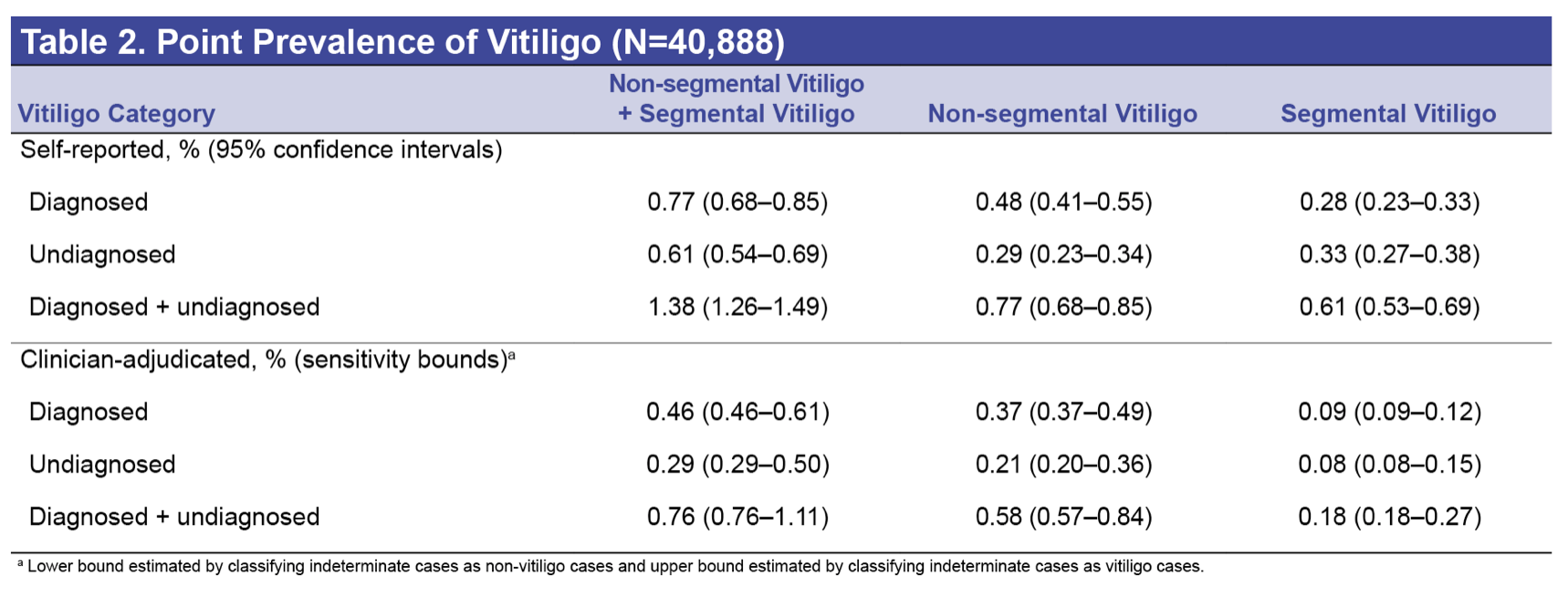New
Study Details Prevalence of Vitiligo in Adults in the US
Vitiligo prevalence is between 0.76% and 1.11% of the U.S. population, including around 40% of those with the condition being undiagnosed, according to a study "Prevalence of Vitiligo Among Adults in the United States."
Worldwide prevalence estimates of vitiligo vary widely, ranging from 0.004% to 2.28% and even higher in certain regions; however, most are outdated, did not include those with undiagnosed vitiligo, sampled from specific groups or extrapolated from other studies.
Method
A new population-based, online survey was conducted between December 2019 and March 2020. The investigation team was lead by Lynne Napatalung, MD, Medical Affairs from Pfizer in New York. A representative sample of the US adult general population, 18 to 85 years of age, was recruited by email invitation. Participants with self-reported diagnosed or undiagnosed vitiligo were invited to upload photographs of their lesions for clinician evaluation. Participant compensation ranged from $2.50 for participants who did not report having vitiligo to $60 for participants who reported having vitiligo and uploaded photographs.
Of 322,240 people asked to participate, 40,888 were eligible for the study. The mean age was 44.9 years, and 56.7% were female. The majority (74.4%) identified themselves as White, while 10.3% participants identified themselves of Hispanic origin. The greatest number of participants (39.8%) resided in the US South geographic region. The mean age at vitiligo onset was 27.6 years for participants with self-reported diagnosed vitiligo compared with 25.0 years for participants with self-reported undiagnosed vitiligo.
The study also estimated the prevalence of segmental and nonsegmental vitiligo for both diagnosed and undiagnosed vitiligo. The distinction between segmental and nonsegmental vitiligo is of prime importance for patients and physicians because these vitiligo forms do not behave in the same manner. The unpredictable nature of nonsegmental vitiligo is of most concern in choosing the proper therapeutic algorithm of vitiligo. The estimates of segmental vitiligo among those with diagnosed vitiligo was higher than the 5% to 16% previously reported in those with vitiligo.
Results
Only results among adults in the US were reported by the researchers. The results of the pediatric population will be published elsewhere.
The current prevalence estimate of vitiligo in the U.S. adults is between 0.76% (1.9 million cases) and 1.11% (2.8 million cases). Additionally, this study suggests that approximately 40% of vitiligo patients may be undiagnosed.
Originally posted on November 18, 2021
UPDATE (Jan 26, 2022): virtual poster presentation at Maui Derm
Prevalence of Vitiligo Among a Nationally Representative Sample of Adults in the United States
Khaled Ezzedine, Kathryn P. Anastassopoulos, Kavita Gandhi, Shoshana R. Daniel, Vanja Sikirica, Reema Patel, Lynne Napatalung, Yuji Yamaguchi, Rebecca Baik, Amit G. Pandya

FAQOther Questions
- Which is better for judging vitiligo — Wood’s lamp or dermoscopy?
A recent study out of India compared the two head-to-head. Both tools correlated fairly well with clinical criteria, but dermoscopy had a slight edge: Wood’s lamp: sensitivit...
- Белые пятна на теле? Витилиго?
Гид по Витилиго — ваш компас в лабиринте загадочной болезни и непростых решений. Здесь всё по-честному, по делу и на понятном языке. Вы найдёте здесь: Объяснения, что прои...
- Who is prone to vitiligo?
Vitiligo can affect anyone, regardless of gender, age, or race. Vitiligo prevalence is between 0.76% and 1.11% of the U.S. population, including around 40% of those with the con...
Though it is not always easy to treat vitiligo, there is much to be gained by clearly understanding the diagnosis, the future implications, treatment options and their outcomes.
Many people deal with vitiligo while remaining in the public eye, maintaining a positive outlook, and having a successful career.
Copyright (C) Bodolóczki JúliaBy taking a little time to fill in the anonymous questionnaire, you can help researchers better understand and fight vitiligo.
